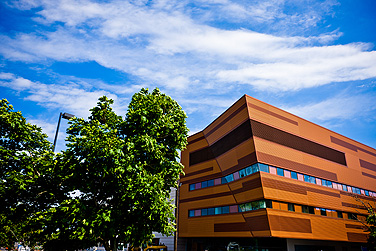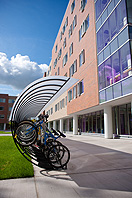News
State of sustainability at UB
Achievements include teaching, research, outreach

Barbara and Jack Davis Hall on the North Campus will house some departments from the School of Engineering and Applied Sciences. Photo: DOUGLAS LEVERE
-
 Print
Print -
 Comments
Comments
-
Multimedia

Greiner Hall is SUNY’s first LEED gold-designed student residence hall. UB students are creating a better future through sustainability. Watch a video.
The April 23 dedication of The Solar Strand, an innovative 3,200-panel solar array on North Campus, will mark a milestone in a year of sustainability achievements at UB.
From the way we produce energy to the research topics we undertake, the university is engaging in projects emphasizing sustainability.
On campus, we’re composting food waste and opening new green buildings. In the classroom and laboratory, we’re exploring solutions to environmental problems. Out in the world, we’re educating the public about water shortages, invasive species and other issues.
The objective is not only to act sustainably, but to conduct research, teaching and outreach that encourage others to do the same, says Ryan McPherson, UB’s chief sustainability officer.
“Sustainability is about meeting today’s needs without sacrificing the needs of the next generation, whether in an environmental, social or economic context,” McPherson says. “There’s no other institution that’s set up to play a more pivotal role than the public research university. At UB, we’re finding solutions to challenges and educating students to become sustainably literate individuals.”
UB created the chief sustainability officer position last September to coordinate initiatives across the university and support the work of UB’s Environmental Stewardship Committee.
“We have seen great progress over the last year in implementing our comprehensive Climate Action Plan. There are a larger number of people involved at every level of the university, and we are taking the positive and concrete steps needed for success,” says Robert G. Shibley, dean of the School of Architecture and Planning and chair of the Environmental Stewardship Committee.
This Earth Day, we celebrate a year of advancements.
Unveiling The Solar Strand
UB will celebrate the opening of its newest sustainability initative on Monday. Funded by the New York Power Authority and designed by renowned landscape architect Walter Hood, The Solar Strand comprises 3,200 panels stretching for a quarter mile along Flint Road on the North Campus.
The installation, a work of landscape art and a gateway to the university, has a maximum rated capacity of 750 kilowatts—enough to power hundreds of student apartments. But the strand’s significance also lies in the fact that it merges sustainability with technology, beauty and public engagement. In coming years, the array and surrounding landscape will serve as a classroom and research site for undergraduates and a field trip destination for K-12 pupils.
Members of the university community are invited to attend the The Solar Strand opening. To register, click here.
Launching a new sustainability portal
On April 16, UB unveiled its new sustainability website. It’s a one-stop-shop where members of the UB community and the public can learn about the university’s latest sustainability initiatives—and how we all can pitch in to make UB greener.
Resources for faculty, staff and students include sections on green solutions for the office, as well as information on getting to and around campus without a car. The site also provides an overview of research and courses tied to sustainability, along with details on how UB is greening operations from dining to facilities management.
Planning a new academy
New green offerings at UB include a BS in environmental geosciences and a Discovery Seminar on sustainability led by engineering faculty member Alan Rabideau. Now, UB is building on these successes by exploring establishment of an Undergraduate Academy for students interested in sustainability, says Rabideau, who chairs the Research, Teaching and Public Service Subcommittee of UB’s Environmental Stewardship Committee.
The new academy, still in the works, could launch as soon as fall 2013. Like members of UB’s three existing academies, students who join the sustainability academy would live together, take seminars, interact with outstanding faculty, volunteer and participate in extracurricular activities. The goal is to introduce sustainability from the perspective of different thinkers in different fields.
“The development of a new Sustainability Undergraduate Academy will expand the unique and exciting living-learning communities we have established for undergraduate students,” says A. Scott Weber, vice provost and dean for undergraduate education. “This effort will further solidify UB’s strong academic focus on sustainability and will help meet strong student interest in this important societal need.”
Opening new LEED buildings
UB is in the midst of completing construction or renovation of six structures designed to earn LEED certification, the standard for green building. New and revamped facilities include William R. Greiner Hall, a sophomore residence hall; Barbara and Jack Davis Hall, the engineering building; UB’s Clinical and Translational Research Center; Crossroads Culinary Center, the residential dining facility in the Ellicott Complex; John and Editha Kapoor Hall, the pharmacy building; and the Educational Opportunity Center.
Greiner Hall, the first to open, debuted in August 2011 as SUNY’s first LEED gold-designed student residence hall. The building is packed with such green features as high-efficiency lighting, low-flow faucets and laundry-room counters made from recycled Tide bottles. Openings for UB’s other new LEED-designed buildings—all part of the campus master plan—are scheduled for 2012 and 2013.
“I look forward to building on UB’s impressive commitment to sustainability by continuing to implement strong green standards for our buildings, while working to reduce our environmental footprint across the university,” says Laura Hubbard, vice president for finance and administration.
Studying our world
Students, staff and faculty across UB are working on research and outreach tied to sustainability. A sampling of projects on just one topic—water—demonstrates how deeply the university is immersed in work to improve our collective future.
Esther Buckwalter, environmental engineering student and winner of the prestigious Morris K. Udall Scholarship, partnered with an Indonesian nonprofit to develop a laboratory for testing ceramic water filters for disaster survivors. Derek Taylor, associate professor of biological sciences, co-authored research showing that threatened freshwater habitats hold more species of ecologically important water fleas than previously thought. Closer to home, Helen Domske, associate director of UB’s Great Lakes Program, educates the public about invasive species and other threats to local lakes.
“Water is just one of a multitude of sustainability subjects that our faculty are studying,” says Alexander Cartwright, vice president for research and economic development. “Our research in smart grids and renewable energy is not only fueling innovative discoveries, but also making a real difference in creating a better tomorrow through smart sustainable solutions.”
Composting waste
Trash, be gone! UB’s on-campus dining centers now are composting 100 percent of pre-consumer food waste and some post-consumer food waste, thanks to a new food decomposer that’s turning chicken bones and banana peels into fertilizer. These efforts, led by Campus Dining and Shops, have kept hundreds of thousands of pounds of trash out of the landfill.
Other new initiatives to curtail trash include making recycling easier by allowing people to place all recyclables in one bin instead of separate containers. Single-stream recycling, as it’s called, debuted on campus in 2011.
Measuring our sustainability
How to keep track of it all? With so many efforts under way, UB is adopting a sustainability assessment system that helps universities measure performance in areas ranging from curriculum to operations. The system is the Association for the Advancement of Sustainability in Higher Education’s Sustainability Tracking Assessment and Rating System (AASHE STARS).
That’s a mouthful, but the idea is simple: AASHE STARS helps administrators look beyond individual projects and evaluate—objectively—how an institution is performing as a whole.
Nearly 100 UB faculty and staff members are working on this project, along with students who are gathering data for the assessment through a class taught by Jim Simon, sustainability engagement coordinator in UB’s Office of Sustainability. Once UB has submitted an analysis, we’ll be able to compare ourselves to similar institutions and identify smart, strategic ways to improve.

Reader Comments